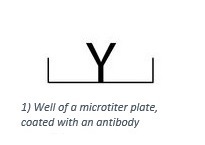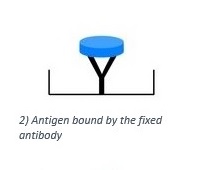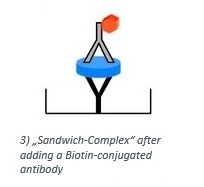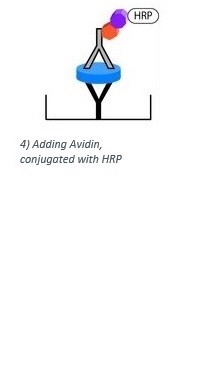ELISA-Kit - Info
What is the meaning of ELISA?
ELISA stands for Enzyme Linked Immuno Sorbent AssayThe ELISA method belongs to the group of immunoassays. Here, the presence of a specific antigen can be revealed by an antibody-coupled enzymatic color reaction. With low material and equipment costs, the analysis of samples by ELISAis a cost-effective alternative compared to more elaborate chromatographic methods such as GC-MS and HPLC.
What is being detected with an ELISA kit?
An ELISA kit of this type contains all the materials and reagents needed to detect proteins, antibodies and viruses, or even low-molecular-weight compounds such as hormones, pesticides, and toxins in a sample.
Coated versus uncoated ELISA kits
A distinction is made between coated and uncoated ELISA kits when selecting a suitable ELISA kit.
A coated ELISA kit, are already provided with a capture antibody, or in the case of an ELISA for the detection of an antibody, with a capture antigen.
The advantage here is the comparability between the ELISA and the rapid execution.
An uncoated ELISA kit must first be coated with the reagents provided.
While this process costs more time, a lower price can be expected here, and in addition, modification of the ELISA test is possible.
How does an ELISA kit (sandwich) work?
 The ELISA kit contains a microtiter plate with 96 individual reaction wells. The bottom of the microtiter plate has been coated with antibodies directed against the antigen of interest (see 1).
The ELISA kit contains a microtiter plate with 96 individual reaction wells. The bottom of the microtiter plate has been coated with antibodies directed against the antigen of interest (see 1).
 In the first step, the sample is added to the reaction chambers of the ELISA kit. If the antigen of interest is present in the sample, it will be bound by the antibodies fixed on the microtiter plate (see 2). It is then important to wash the plate to remove unbound components that would confound the measurement.
In the first step, the sample is added to the reaction chambers of the ELISA kit. If the antigen of interest is present in the sample, it will be bound by the antibodies fixed on the microtiter plate (see 2). It is then important to wash the plate to remove unbound components that would confound the measurement.
 In the second step, another polyclonal antibody, which is linked to a reporter enzyme (e.g. biotin), is added to the antibody-antigen complex. This "detection antibody" (included in the ELISA kit as "Detection Reagent A") binds to other epitopes (binding sites) of the antigen than the first fixed one. In this way, a so-called "sandwich complex" of first antibody, antigen and second antibody is formed (see 3).
In the second step, another polyclonal antibody, which is linked to a reporter enzyme (e.g. biotin), is added to the antibody-antigen complex. This "detection antibody" (included in the ELISA kit as "Detection Reagent A") binds to other epitopes (binding sites) of the antigen than the first fixed one. In this way, a so-called "sandwich complex" of first antibody, antigen and second antibody is formed (see 3).
Rewashing ensures the removal of unbound enzyme conjugates and thus an unbiased measurement result.
 Following this, the property of avidin (chicken egg white) to bind biotin is used to bind the enzyme (HRP = horse radish peroxidase) required for the color reaction to the "sandwich complex". For this purpose, avidin conjugated with HRP (included as Detection Reagent B in the ELISA Kit) is added to the individual reaction wells of the microtiter plate (see 4).
Following this, the property of avidin (chicken egg white) to bind biotin is used to bind the enzyme (HRP = horse radish peroxidase) required for the color reaction to the "sandwich complex". For this purpose, avidin conjugated with HRP (included as Detection Reagent B in the ELISA Kit) is added to the individual reaction wells of the microtiter plate (see 4).
The intermediate step via avidin-biotin binding serves to amplify the signal and is particularly useful when the compound to be detected is present in very small amounts. Before the color reaction can be initiated, it is important to remove unbound enzyme conjugates from the reaction chambers by washing again.
The enzymatic color reaction is induced by the addition of an initially colorless substrate (TMB = 3, 3’, 5, 5’- tetramethylbenzidine), which shows a dark blue coloration in the presence of peroxidases. After a certain reaction time, the enzyme (HRP) is denatured by the addition of an acid (e. e.g. sulfuric acid) and the reaction is thus stopped. In this process, due to the change in pH, the color of the TMB turns from blue to yellow.
The color intensity (absorbance) can be determined photometrically at an absorbance maximum of 450 nm using a microplate reader Comparison of the measured absorbance with a previously generated standard line allows accurate quantification of the compound to be detected in the sample.
How does a sandwich ELISA kit differ from a competitive ELISA?
The sandwich approach focuses purely on the presence of an analyte to be detected. If it is present, the detection antibody can bind and the procedure results in a measurable signal. The signal strength is proportional to the amount of analyte: the more analyte present in the sample, the more detection antibodies can bind and the stronger the signal.
Competitive ELISA, on the other hand, relies on competition between the analyte to be detected and a competitor antigen. This competitor antigen replaces the detection antibody and is therefore labeled with a signal-generating substance.
While the ELISA is a competitive assay, it is a competitive assay.
While the analyte to be detected is not in the experimental setup, the competitor antigen binds to the fixed antibody. However, the binding between the two is somewhat weaker, compared to the binding between the fixed antibody and the analyte to be detected.
If a sample is run, the antibody will bind to the fixed antibody, but not to the analyte to be detected.
When a sample containing the analyte to be detected is now added, both analytes compete for binding to the fixed antibody.
The experimental design is such that the analyte to be detected displaces the competitor antigen from the binding surface. Since the competitor antigen carries the fraction, the measured signal intensity is inversely proportional to the amount of analyte to be detected: the more analyte present in the sample, the fewer competitor antigens can bind and the weaker the signal.
Why are monoclonal antibodies often used in a sandwich ELISA test?
The use of fixed monoclonal antibodies enables accurate binding of the antigen to be detected. Here, the antigen should be bound uniformly and, as far as possible, no cross-reaction to other proteins within the sample should occur.
On the other hand, polyclonal antibodies can be used to detect the bound analyte, since on the one hand other proteins have been washed away by the previous washing steps, and on the other hand the binding of several antibodies to one analyte helps to make the ELISA test sufficiently sensitive even with small sample quantities.
Biotin and Streptavidin in Sandwich ELISA Kits
Biotin and streptavidin are commonly used in a sandwich enzyme-linked immunosorbent assay (ELISA) for their strong and specific binding properties, which allow for sensitive detection of target analytes.
In a sandwich ELISA, the basic principle is to capture the analyte of interest, typically a protein or antigen, using a pair of antibodies. One antibody, known as the capture antibody, is immobilized onto a solid surface, such as a microplate well, and serves to capture the analyte from the sample. The other antibody, known as the detection antibody, is conjugated to an enzyme and serves to detect the captured analyte.
Biotin is a small vitamin that can be easily conjugated to proteins, including antibodies, through chemical reactions. Streptavidin, on the other hand, is a protein derived from Streptomyces bacteria that has an extremely high affinity for biotin, making it one of the strongest known non-covalent interactions in nature.
In a sandwich ELISA, the capture antibody is immobilized onto the solid surface of the microplate well, and the analyte from the sample is captured by binding specifically to the capture antibody. Then, the detection antibody, which has been conjugated to biotin, is added to the well. The biotinylated detection antibody binds specifically to a different epitope on the captured analyte, forming a "sandwich" complex with the capture antibody.
Next, streptavidin conjugated to an enzyme, such as horseradish peroxidase (HRP) or alkaline phosphatase (AP), is added to the well. Streptavidin binds to the biotinylated detection antibody with high affinity, creating a bridge between the capture antibody-analyte complex and the enzyme-labeled detection antibody.
After washing to remove unbound components, a substrate solution containing a substrate specific to the enzyme is added to the well. The enzyme on the streptavidin then reacts with the substrate, generating a detectable signal, such as a color change or luminescence, which is proportional to the amount of analyte present in the sample. This signal can be measured using a microplate reader, allowing for quantification of the analyte concentration.
The use of biotin and streptavidin in a sandwich ELISA provides several advantages, including high sensitivity and specificity due to the strong and specific biotin-streptavidin interaction. It also allows for flexibility in assay design, as different biotinylated detection antibodies can be used in combination with the same streptavidin-conjugated enzyme, enabling multiplexing and customization of the assay for different analytes.
ELISA tests find application in the fight against Corona
In light of the SARS-CoV-2 pandemic, the ELISA test principle also found appeal in the diagnosis of antibodies detectable in the bodies of recovered individuals in the course of a survived SARS-CoV-2 infection. Here, for example, the isotype and specific binding to the spike protein of the virus may prove particularly useful.
From this train of thought, so-called Neutralization Assays also developed.
Neutralization assays help detect circulating neutralizing antibodies to SARS-CoV-2. Particularly in light of survived COVID-19 disease, as well as the ongoing vaccination process, this can provide important insights into antibodies to SARS-CoV-2.
The actual "neutralization" is based on blocking the interaction between the receptor-binding domain (RBD) of the viral spike glycoprotein with the ACE2 cell surface receptor.
Thus, here the neutralizing antibodies act in the same way as the competitor antigen in the case of a competitive ELISA.
What should you look for when buying an ELISA test?
As a scientist, you are most familiar with your own experimental set-up and the problem to be solved.
When selecting a suitable ELISA, you should nevertheless think carefully about the following points:
- From which species does the antigen to be detected come? (Filter: Specific Against)
- Do you have a preference for a specific manufacturer? (Filter: Manufacturer)
- Should it be a direct-, indirect-, sandwich- or competitive ELISA
In the respective brackets you will find the respective filter section, through which you can define within your search on the left side of the screen, exactly the product you are looking for.
Which ELISA kits can you buy from Hölzel?
We have been selling ELISA kits for research and diagnostics since 1993.
Over the years, we have been able to build a substantial portfolio with more than 100 ELISA manufacturers and over 1 million ELISA kits.
In the following we have picked out a few interesting ELISA kits.
| Name | article no. | Specially against | Manufacturer |
| ELISA Kit for Interferon Gamma (IFNg) - 96T | SEA049Eq | Equine | Cloud clone |
| COVID-19 Human IgG ELISA Kit | IEQ-CoVS1RBD-IgG-1 | Human | Raybiotech |
| Mouse lung surfactant-associated protein C (SP-C) ELISA kit | CSB-E12639m | Mouse | Cusabio |
| QuickTiter MuLV Core Antigen ELISA Kit | VPK-156m | MuLV core antigen (p30) | Cell Biolabs |
| Parainfluenza virus IgA ELISA | DRG-EIA-3871 | Human | DRG Instruments |
| Human Neurotrophin-3 PicoKine ELISA Kit | BOS-EK0472 | Human | Boster |
| Mouse D-Dimer ELISA Kit | abx258705-96 | Mouse | abbexa |
| Ultra Sensitive Mouse Insulin ELISA Kit | 90080 | Mouse | Crystal Chemistry |
| Pig Myoglobin ELISA Kit | LD-MYO-9 | Pig | Life Diagnostics |
If this selection hasn't helped yet, feel free to send us a product inquiry.



